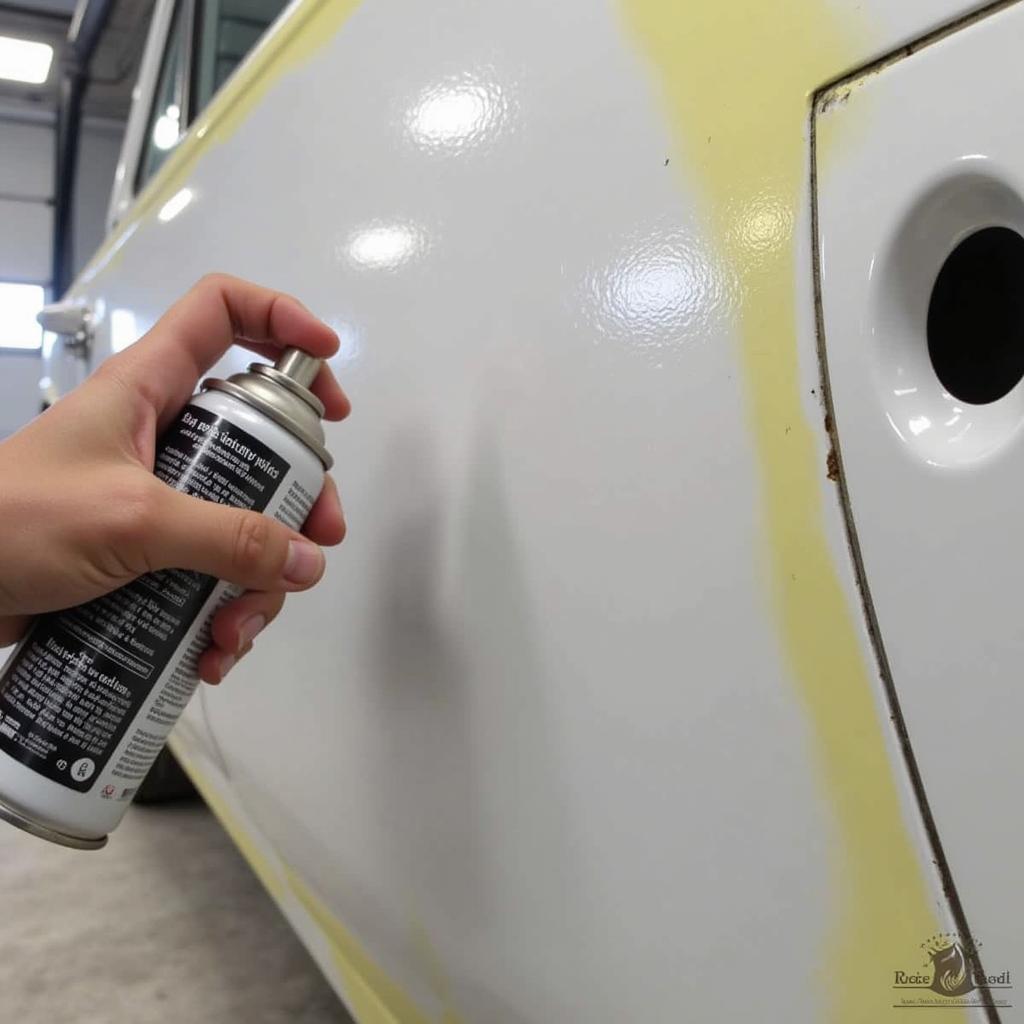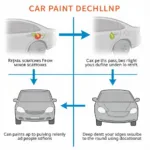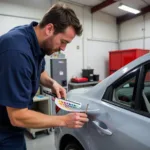Rust, that insidious enemy of your car’s finish, can quickly turn a minor blemish into a major eyesore. Fortunately, dealing with simple surface car rust repair and paint is often manageable with DIY techniques, saving you a trip to the auto body shop. This guide will provide a step-by-step approach to tackling those pesky rust spots and restoring your car’s appearance.
Before diving into the repair process, it’s crucial to assess the extent of the rust damage. Surface rust, as the name suggests, affects only the top layer of paint and is characterized by small, discolored spots. If the rust has penetrated deeper and created holes or extensive bubbling, professional help is highly recommended. For minor surface rust, however, you can confidently tackle the repair yourself. First, you’ll need to gather the necessary tools and materials. These include sandpaper (various grits), masking tape, primer, automotive paint (matching your car’s color), clear coat, and rubbing compound. You may also consider a rust converter product for added protection. Remember safety first! Always wear protective gloves and eyewear when working with these materials. Check out our guide on how to repair a car paint chip for related tips.
Preparing the Affected Area for Rust Repair
Proper preparation is key to a successful rust repair. Begin by thoroughly cleaning the rusty area with soap and water to remove any dirt or debris. Then, using coarse sandpaper (around 180-grit), sand down the rusted area until all traces of rust are gone. how to repair rust on car paint provides more detail on this critical step. You should see bare metal beneath the affected paint. Feather the edges of the sanded area to ensure a smooth transition between the bare metal and the surrounding paint. This blending is essential for achieving a seamless finish after painting. Once you’ve sanded the area, clean it again with a degreaser to remove any sanding dust or oils.
Priming and Painting the Repaired Area
After prepping the area and ensuring it’s completely dry, apply a thin, even coat of automotive primer. Primer acts as a protective layer, preventing future rust formation and providing a good surface for the paint to adhere to. Allow the primer to dry completely according to the manufacturer’s instructions. Once the primer is dry, you can start applying thin coats of automotive paint that matches your car’s color. Remember, several thin coats are better than one thick coat, as this prevents runs and ensures even coverage. Allow each coat of paint to dry thoroughly before applying the next. For more complex paint issues, see our guide on car paint flaking repair.
Finishing Touches and Protecting Your Repair
After the final coat of paint has dried, apply a few coats of clear coat to protect the paint and add a glossy finish. Once the clear coat is dry, use a rubbing compound to blend the repaired area seamlessly with the surrounding paintwork. This will remove any imperfections and create a smooth, uniform surface. Finally, apply a coat of wax to the entire panel to protect the newly repaired area and enhance the shine. If you need visual guidance, our guide on how to repair paint chips on a car video may be helpful. Maintaining your car’s paint job is ongoing. Regularly washing and waxing your car can significantly reduce the risk of future rust formation.
 Applying Clear Coat to Car Rust Repair
Applying Clear Coat to Car Rust Repair
Conclusion
Simple surface car rust repair and paint is a manageable DIY project that can restore your car’s appearance and protect it from further damage. By following these steps and exercising patience, you can achieve professional-looking results and save yourself the cost of professional repairs. Remember to address rust issues promptly to prevent them from becoming more serious and costly problems. Need help with rust originating from paint chips? Check out our guide on repair car paint chips rust.
FAQ
- What type of sandpaper should I use for rust repair? Use a variety of grits, starting with coarser (180-grit) for rust removal and progressing to finer grits for smoothing.
- Can I use any type of paint for car rust repair? Use automotive paint specifically designed for cars to ensure durability and color match.
- How long does it take for the paint to dry? Drying times vary depending on the product and environmental conditions, so always refer to the manufacturer’s instructions.
- How can I prevent rust from forming again? Regular washing, waxing, and addressing paint chips promptly can help prevent rust.
- When should I seek professional help for rust repair? If the rust has penetrated deep into the metal, creating holes or significant bubbling, it’s best to consult a professional.
- Is it necessary to use primer? Yes, primer is essential for preventing future rust and providing a good surface for paint adhesion.
- How many coats of paint should I apply? Apply multiple thin coats rather than one thick coat for even coverage and to prevent runs.
You might also be interested in topics such as: understanding different car paint types, techniques for removing deep scratches, and choosing the right car wax for your climate. For further assistance, please contact us via WhatsApp: +1(641)206-8880 or Email: [email protected]. Our customer service team is available 24/7.


